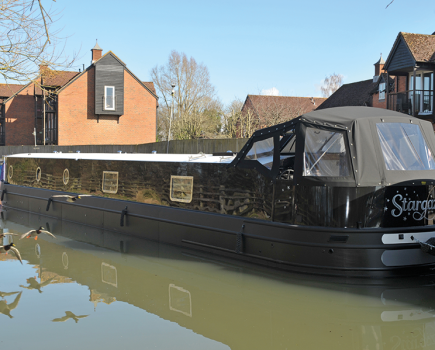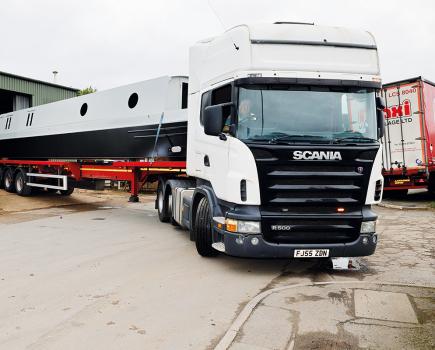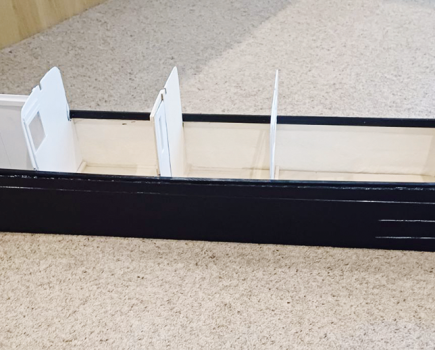Howard and Melanie Leader’s holidays lead to a career in canal art

As I carefully piloted the hire boat away from the wharf reciting the list of training points from our briefing session of the last hour, with my wife Melanie watching the sides for clearances and the engine on tick-over to pass the line of moored boats, I could not have known then just how much that first canal holiday would change our lives.
We were hiring from a small, private boatyard to explore the Ashby canal, my reasoning being that with only a stop-lock on the way it would be a relatively trouble-free cruise for a pair of first-timers. We did all the things that first-timers do, admired the scenery, stopped at delightful pubs, diligently turned the grease gun at night, unclogged the plastic bags from the weed box, hit our heads on the low hatch opening, watched a mooring cleat disappear into the murky depths and admired the bravery of our dog barking fearlessly at swans from the safety of the moving deck. But there was something else having a slower, yet more profound effect on us. While the boating bug buried its mouth parts into me, Melanie was being drawn to the picture panels and rose clusters painted on the boats we passed and soon the memory card on our camera was filling with pictures of Buckby Cans, planters, pigeon boxes and milk churns.
Melanie has always been an artist but neither of us had heard of canal art before that trip and by the end of the holiday, as I was burbling on about Lister engines and the merits of semi-trad over the cruiser-deck, Melanie announced that she intended to research this art form as she had found her medium.
In the months that followed she applied herself to learning as much as possible about the canal art tradition and began experimenting with some of its forms.
Canal art has its origins in the very beginnings of the canal story, evolving as the modern era canal network grew in this country. We know that agricultural wagons and carts of the 18th century were decorated with rose clusters against brightly painted blue, green or red panels carefully lined-out in yellow and it was not long before the canal’s need for experienced horse-operators saw some agricultural workers leave the land for a life on the cut. With those early pilots came their painted roses designs to brighten their cabins and deck equipment, which explains the floral element in the work. The castle scenes in the Roses & Castles tradition are harder to pin down, although it seems that artists employed in the ceramics industry painting landscapes onto china plates were employed on piece-work and may well have earned extra money by painting castle scenes with similar elements to their ceramicware onto the decorative boat panels. This does not explain the rather fantastical style of canal castles but is an historical best guess. What is certain is that over time this style, which originated in the Midlands, settled into a very specific art form carried on narrowboats up and down the country.
There are some local differences in painting style, most notably on the Leeds-Liverpool canal where Brightwork substitutes roses for ornate scrolls and the castles scenes give way to cottages, windmills and sailing boats. The basic principle, however, remains the same – domestic areas and equipment lavishly painted to brighten the boatman’s life. Canal art is not subtle – to be visible from the towpath it has to be bold, bright and striking. Neither is it “fine”, canal art has its roots in folk art and over the past two-and-a-half centuries has been applied by professional painters and hobby painters alike. But it is now an established “traditional” style with its “rules” about colour pallet, motifs, icons and lettering, all of which Melanie soaked up under the expert tuition of Master Craftsman Dave Moore.
Our annual hire-boat holidays continued, Melanie’s collection of inspirational photos carried on growing and so did the number of people approaching her to paint panels and objects for their boats and homes. She achieved a Journeyman qualification as a “decorative painter” from the Waterways Crafts Guild and I had to build a studio in our garden.
Over time, Melanie’s enthusiasm for sharing the story of canal art saw her undertake a series of illustrated talks for clubs, art-groups and societies and gradually seek other ways to bring canal art to a wider audience. In 2016, to mark 900 years since the Barons forced the signing of Magna Carta, the city of Lincoln launched it’s “Baron’s trail” a street art project featuring identical statues of medieval Barons painted in different styles to represent Lincolnshire life. Melanie saw an opportunity to celebrate Lincolnshire’s waterways heritage and created a Baron of the Waterways carrying all the traditional canal art motifs with some “local” adaptations bringing Tattershall Castle into one panel and Lincoln Castle into another. The trail organisers decided that the most appropriate place for a Baron of the Waterways would be beside the Brayford Wharf in the city centre where a number of canal boats are moored. We little expected that the event would be launched by the arrival of Melanie’s Baron on a boat along the River Wytham and winched into place at the Brayford as the trail was declared “open”.
Since then Melanie has shown work in “main-stream” art exhibitions, adhering strictly to the canal art tradition but always looking for new audiences – which brings us to 2019. Early in the year, when the closest most people get to narrow-boating is reading Canal Boat in front of the fire with a steaming mug of hot chocolate, top garden designer Mark Gregory was hard at work on his master plan for an extraordinary creation for this year’s Chelsea Flower Show. His pride in the county of his birth is evident from previous acclaimed gardens and this year he turned his attention to the waterways, designing a garden depicting a rural lock with keeper’s lodge in a stunning semi-wild garden setting.
Such is Mark Gregory’s attention to detail that he tries to ensure that everywhere the eagle-eyed judges might look there will be something interesting to see. So it came about that Melanie was asked to create a small collection of bespoke canal art pieces to decorate the interior of the lodge. In Mark’s all-important back-story for the garden, he imagined that the lock keeper, with a passion for the canal he serves, has lovingly collected a number of “pieces” over the years which he keeps in the lodge to remind him of a life-time on the cut. Accordingly, Melanie designed a pair of cabin doors in traditional roses and castles style, a milk churn in the field colour of the Yorkshire flag with the white rose prominent in the design and a stylised Skipton Castle in the picture panel, a picture board hat rack in the Leeds-Liverpool Brightwork style depicting Bingley Five Rise locks and some sundry billy cans and planters to go on the desk and shelves. This collection was duly installed in the lodge and immediately became one of the “secrets” of the Welcome to Yorkshire garden as it was only ever seen by the judges and VIP guests while Chelsea Flower Show visitors caught no more than a tantalising glimpse of the art work through the open lodge door.
The garden went on to win a Chelsea Flower Show Gold and the people’s choice for Best Garden in Show. Such was the interest in the garden that Standedge Tunnel Visitor Centre agreed to reveal the “secret” of the WTY garden by putting the garden artwork on exhibition where it can be seen until the end of October.
Ten years on we still enjoy our annual hire boating and, as I stand at the tiller accompanied by the gentle thrum of the engine while we drift along, my mind goes back to that first experience on the Ashby. That trip launched us on this most remarkable of journeys, and I admit to basking in reflected pride when a boat goes the other way with a familiar piece of art on top.
The collection is now on exhibition at the Standedge Tunnel Visitor until the end of October. Have a look at the link
Image(s) provided by:
Archant







